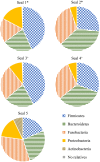Comparative analysis of the fecal bacterial community of five harbor seals (Phoca vitulina)
- PMID: 27734626
- PMCID: PMC5061715
- DOI: 10.1002/mbo3.369
Comparative analysis of the fecal bacterial community of five harbor seals (Phoca vitulina)
Abstract
The gut microbiota has many beneficial effects on host metabolism and health, and its composition is determined by numerous factors. It is also assumed that there was a co-evolution of mammals and the bacteria inhabiting their gut. Current knowledge of the mammalian gut microbiota mainly derives from studies on humans and terrestrial animals, whereas those on marine mammals are sparse. However, they could provide additional information on influencing factors, such as the role of diet and co-evolution with the host. In this study, we investigated and compared the bacterial diversity in the feces of five male harbor seals (Phoca vitulina). Because this small population included two half-brother pairs, each sharing a common father, it allowed an evaluation of the impact of host relatedness or genetic similarity on the gut microbial community. Fresh feces obtained from the seals by an enema were analyzed by fluorescence in situ hybridization and amplicon sequencing of 16S rRNA genes. The results showed that the bacterial communities in the seals' feces mainly consisted of the phyla Firmicutes (19-43%), Bacteroidetes (22-36%), Fusobacteria (18-32%), and Proteobacteria (5-17%) . Twenty-one bacterial members present in the fecal samples of the five seals contributed an average relative abundance of 93.7 + 8.7% of the total fecal microbial community. Contrary to all expectations based on previous studies a comparison of the fecal community between individual seals showed a higher similarity between unrelated than related individuals.
Keywords: Gut bacteria; microbial ecology; microbiome..
© 2016 The Authors. MicrobiologyOpen published by John Wiley & Sons Ltd.
Figures



References
-
- Ambrose, N. S. , Johnson M., Burdon D. W., and Keighley M. R. B.. 1985. The influence of single dose intravenous antibiotics on faecal flora and emergence of Clostridium difficile . J. Antimicrob. Chemother. 15:319–326. - PubMed
MeSH terms
Substances
LinkOut - more resources
Full Text Sources
Other Literature Sources
Medical

